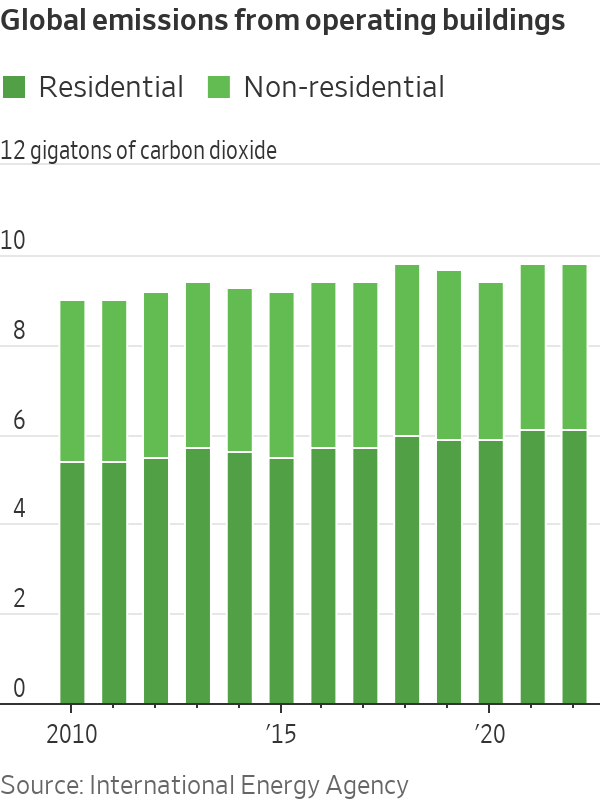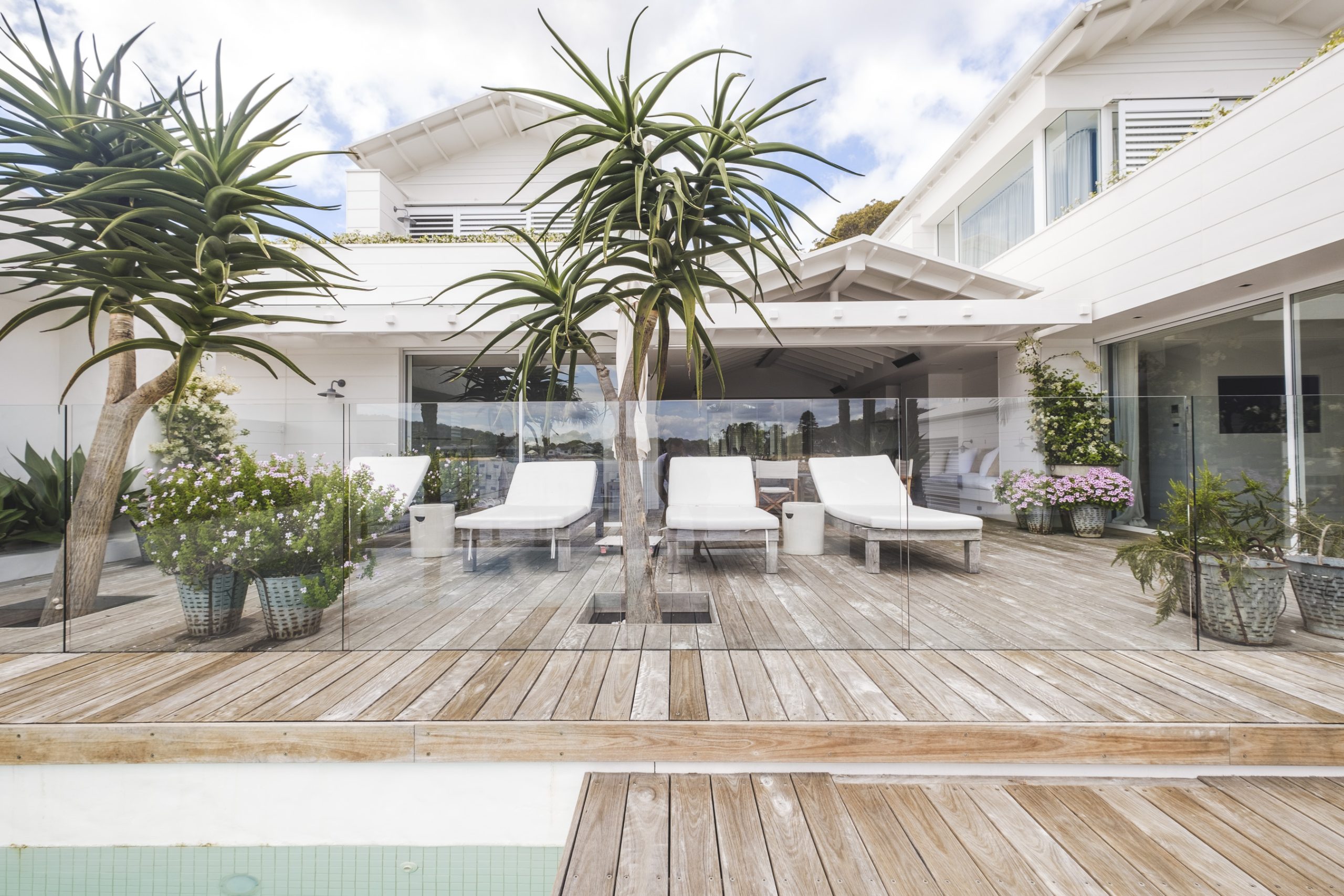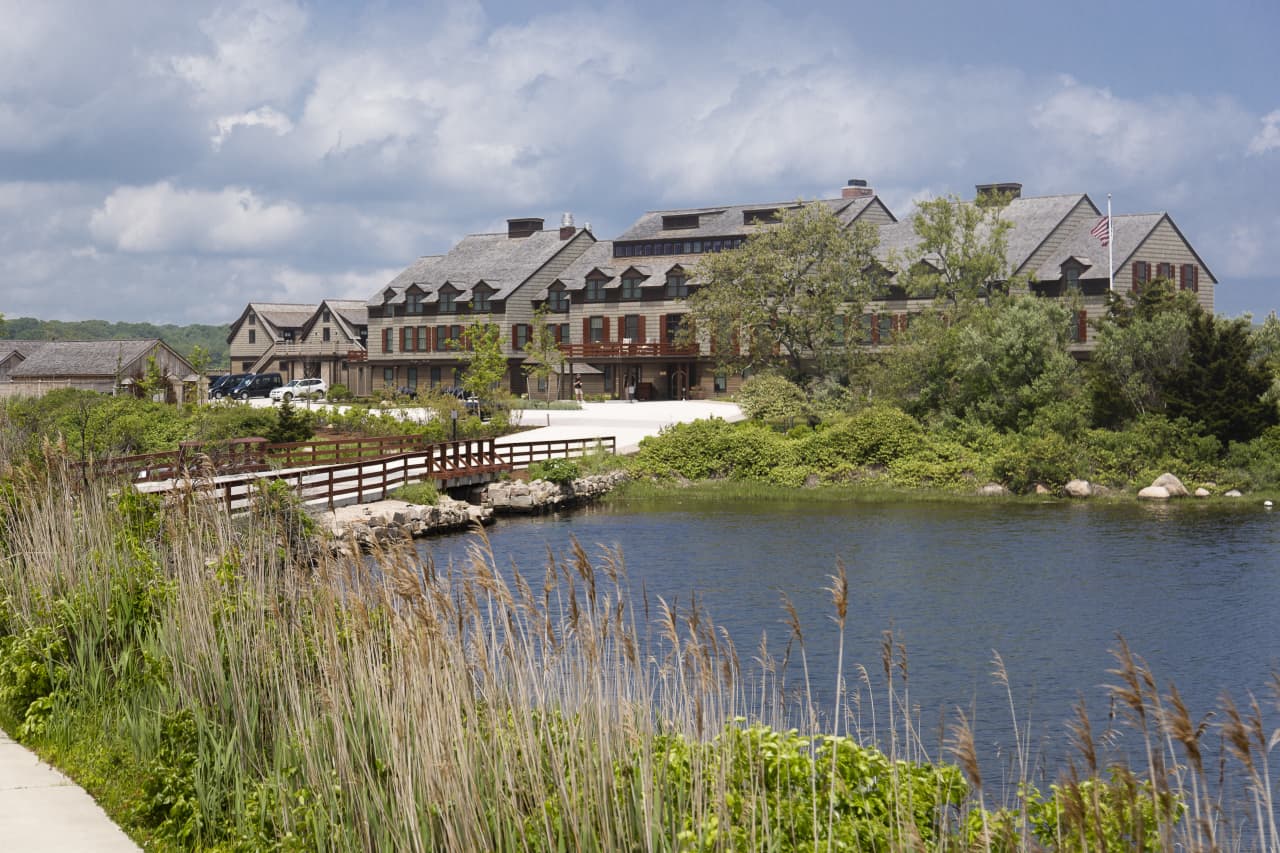Artificial Intelligence Steps In to Lower Carbon Footprint of Buildings
Property companies are increasingly offering AI energy software to help cut the greenhouse-gas emissions of buildings
Artificial intelligence is starting to help buildings go greener.
Keeping our buildings running contributed roughly 26% of global energy-related greenhouse-gas emissions in 2022, according to the International Energy Agency. For the world to reach net-zero emissions by 2050, the agency says the energy that these buildings consume per square meter (around 11 square feet) needs to decline by around 35% by 2030.
Developers and construction companies have pursued more-efficient energy use in buildings over the past couple of decades. Leadership in Energy and Environmental Design, or LEED, certifications are given to buildings that meet standards that conserve energy, water, waste and other environmental goals.

Governments are also introducing increasingly stringent energy codes for commercial spaces. Still, more than 80% of buildings don’t have smart systems to efficiently manage their energy use.
JLL, which manages billions of square feet of commercial real estate around the world, has been making a string of investments to bring AI systems to companies looking to cut their emissions. The business case: Eco-friendly buildings charge higher rents and are on the market for less time. JLL says it expects 56% of organisations to pay a premium for sustainable spaces by 2025.
“We want to make every building out there as smart as it can be,” said Ramya Ravichandar, JLL Technologies’s vice president, technology platforms—smart and sustainable buildings. “If you can’t measure what matters, you can’t make the change.”
JLL’s investments include in Turntide, a company based in Sunnyvale, Calif. that installs electric motors coupled with small computers which learn from patterns to more precisely control heating and cooling, and Envio Systems, a Berlin-based company that develops sensors to track a building’s use, occupancy and other factors to adjust lighting, cooling and similar energy-related activities.
“Do I need to keep the lights on? Do I need to turn off the air conditioning on floor three because the entire company is working from home this week?,” Ravichandar said. “If you have a system, it is relentless and constantly processing this information.”
Generally, AI building systems learn from historical patterns and the daily habits of occupants to predict and power things on and off. For instance, software and hardware that automatically manages lights, heating and cooling can help buildings cut 20% or more of their yearly energy use.
Nevertheless, hurdles remain to installing more AI systems, including gathering data from a wide range of sources in buildings, such as sensors, which often aren’t interconnected enough. “Retrofitting existing buildings with such sensors and infrastructure, as well as ensuring consistent data quality, can be resource intensive,” Ravichandar said.
Not enough data
AI has big potential to cut the emissions of buildings, but it is only as good as the data it learns from. Only 10% to 15% of buildings have the equipment or systems in place to gather the data needed to support AI, said Thomas Kiessling, chief technology officer of Siemens Smart Infrastructure. “AI in buildings works if you have the data,” he said. “Bad data means you can’t do any kind of schedules, rules or more sophisticated use cases around artificial intelligence. You have to have the data.”
Siemens uses AI to compare one building to a thousand similar buildings to predict what the energy savings could be after an upgrade to a smart-energy management system.
“Even if you just know the address of that commercial building, and maybe you have the energy bill, and maybe you have some high level information of what kind of HVAC brand the building uses, that is these days enough to compile a profile of the building with respect to what is likely you could reap,” Kiessling said.
Otherwise, lower-cost sensors, such as for lighting and cooling, can help save energy for companies that don’t have a sophisticated management system.
Venture-capital firm Fifth Wall’s $500 million fund is focused on decarbonising buildings and invests roughly a third of its money in startups with some kind of AI offering, both in software and hardware, the fund’s co-manager Greg Smithies said. A bigger focus is using more sustainable materials, such as concrete and steel made with renewable energy.
Smithies says AI can help with quickly and cheaply identifying where it makes economic sense to upgrade buildings, fill out permits that vary between countries, draw up mock-ups of designs and come up with chemistry for sustainable materials.
“The main message overall is we’re not going to save the planet with software, and AI is software,” Smithies said. “But AI is an interesting piece of the puzzle.”
 Copyright 2020, Dow Jones & Company, Inc. All Rights Reserved Worldwide. LEARN MORE
Copyright 2020, Dow Jones & Company, Inc. All Rights Reserved Worldwide. LEARN MORE
This stylish family home combines a classic palette and finishes with a flexible floorplan
Just 55 minutes from Sydney, make this your creative getaway located in the majestic Hawkesbury region.
The Republican nominee says it would help bring down home prices, though these buyers account for a fraction of U.S. home sales
Former President Donald Trump said he would ban undocumented immigrants from obtaining home mortgages, a move he indicated would help ease home prices even though these buyers account for a tiny fraction of U.S. home sales.
Home loans to undocumented people living in the U.S. are legal but they aren’t especially common. Between 5,000 and 6,000 mortgages of this kind were issued last year, according to estimates from researchers at the Urban Institute in Washington.
Overall, lenders issued more than 3.4 million mortgages to all home purchasers in 2023, federal government data show.
Trump, the Republican presidential nominee, made his comments Thursday during a policy speech to the Economic Club of New York in Manhattan.
Housing remains a top economic issue for voters during this presidential election. Rent and home prices grew at historic rates during the pandemic and mortgage rates climbed to levels not seen in more than two decades. A July Wall Street Journal poll showed that voters rank housing as their second-biggest inflation concern after groceries.
Both major candidates for the 2024 presidential election have made appeals to voters on housing during recent campaign stops, though the issue has so far featured more prominently in Vice President Kamala Harris ’s campaign.
Trump has blamed immigrants for many of the nation’s woes, including crime and unemployment. Now, he is pointing to immigrants as a cause of the nation’s housing-affordability crisis. Yet some affordable-housing advocates and real-estate professionals said Trump’s mortgage proposal would fail to bring relief to priced-out home buyers.
“It’s unfortunate that given the significant housing affordability crisis that is widely acknowledged across most partisan lines, we are arguing about a minuscule segment of the market,” said David Dworkin, president of the National Housing Conference, an affordable-housing advocacy group.
Gary Acosta, chief executive of the National Association of Hispanic Real Estate Professionals, a trade organization, said, “It’s just another effort to vilify immigrants and to continue to scapegoat them for any issues that we have here in the United States.”
A Trump campaign spokeswoman didn’t immediately respond to a request for comment.
Undocumented immigrants in the U.S. can obtain an obscure type of mortgage designed for taxpayers without Social Security numbers, most of whom are Hispanic. The passage of the USA Patriot Act of 2001 allowed banks to use identification numbers from the Internal Revenue Service as an alternative to Social Security, extending a number of financial services to people without legal status for the first time.
Mortgage loans for undocumented immigrants are typically higher interest and borrowers include legal residents who have undocumented spouses, Acosta said. Lenders include regional credit unions and community-development financial institutions.
In his speech, Trump said that “the flood” of undocumented immigrants is driving up housing costs. “That’s why my plan will ban mortgages for illegal aliens,” he said.
Trump didn’t elaborate on how he would enact a ban on such loans.
Though mortgages for undocumented people living in the U.S. are relatively rare, residential real-estate purchases by foreign nationals are big business , especially in expensive coastal cities such as New York and Los Angeles. These sales have declined in recent years, however.
Close to half of foreign purchases are made by people residing abroad, while the other half are made by recent immigrants or residents on nonimmigrant visas, according to an annual survey by the National Association of Realtors. Many affluent foreigners buy U.S. homes with cash instead of obtaining mortgage financing.
In his Thursday speech, which focused mostly on other economic matters such as energy and taxation, Trump proposed other measures to bring down housing costs, including cutting regulations for builders and allowing more building on federal land. Similar ideas appeared in the housing policy outline Harris released in August .
The former president has spoken on housing-related issues in speeches at other recent campaign stops, including in Michigan last month, where he touted his administration’s 2020 overturn of a policy that had encouraged cities to reduce racial segregation .
“I keep the suburbs safe,” Trump said. “I stopped low-income towers from rising right alongside of their house. And I’m keeping the illegal aliens away from the suburbs.”
This stylish family home combines a classic palette and finishes with a flexible floorplan
Just 55 minutes from Sydney, make this your creative getaway located in the majestic Hawkesbury region.






















